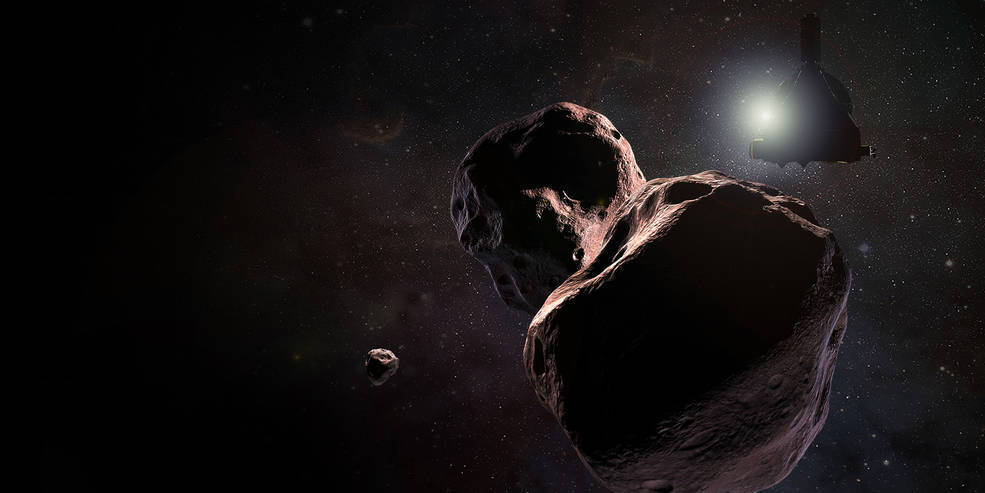In
July of 2015
, NASA's
*New Horizons*
mission made history when it became the first spacecraft to conduct a flyby of Pluto. Since that time, the spacecraft's mission was extended so it could make its way farther into the outer Solar System and explore some Kuiper Belt Objects (KBOs). Another historic first, the spacecraft will study these ancient objects in the hopes of learning more about the formation and evolution of the Solar System.
By Jan. 1st, 2019, it will have arrived at its first destination, the KBO known as 2014 MU69. And with the help of the public, this object recently received the nickname
"Ultima Thule"
("
ultima thoo-lee"
). This object, which orbits our Sun at a distance of about 1.6 billion km (1 billion miles) beyond Pluto, will be the most primitive object ever observed by a spacecraft. It will also be the farthest encounter ever achieved in the history of space exploration.
[caption id="attachment_136714" align="aligncenter" width="580"]
Artist's concept of Kuiper Belt object 2014 MU69, the next flyby target for NASA's New Horizons missionCredits: NASA/JHUAPL/SwRI/Alex Parker[/caption]
In 2015, MU69 was identified as one of two potential destinations for the
New Horizons
mission and was recommended to NASA by the mission science team. It was selected because of the immense opportunities for research it presented. As Alan Stern, the Principle Investigator (PI) for the
New Horizons
mission at the
Southwest Research Institute
(SwRI),
indicated at the time
:
Originally, the KBO was thought to be a spherical chunk of ice and rock. However, in
August of 2017
, new occultation observations made by telescopes in Argentina led the team to conclude that MU69 could actually be a large object with a chunk taken out of it (an "extreme prolate spheroid"). Alternately, they suspected that it might be two objects orbiting very closely together or touching – aka. a close or contact binary.
Given the significance of
New Horizons
' impending encounter with this object, its only proper that it receive a an actual name. In medieval literature and cartography, Thule was a mythical, far-northern island. Ultima Thule means "beyond Thule", which essentially means that which lies beyond the borders of the known world. This name is highly appropriate, since the exploration of a KBO is something that has never been done before.
[caption id="attachment_129018" align="aligncenter" width="580"]
This artist's impression shows the New Horizons spacecraft encountering a Pluto-like object in the distant Kuiper Belt. (Credit: NASA/Johns Hopkins University Applied Physics Laboratory/Southwest Research Institute/Steve Gribben)[/caption]
As Alan Stern, the principal investigator of the
New Horizons
mission at the Southwest Research Institute, said in a recent NASA
press release
:
The campaign to name this object was launched by NASA and the
New Horizons
team in early November, and was hosted by the SETI Institute and led by Mark Showalter - an institute fellow and member of the
New Horizons
science team. The campaign involved 115,000 participants from around the world who nominated 34,000 names - 37 of which were selected for a final ballot based on their popularity.
These included eight names suggested by the
New Horizons
team and 29 nominated by the public. The team then narrowed its selection to the 29 publicly-nominated names and gave preference to names near the top of the polls. Along with Ultima Thule, other names that were considered included Abeona, Pharos, Pangu, Rubicon, Olympus, Pinnacle and Tiramisu.
[caption id="attachment_122086" align="aligncenter" width="580"]
This chart shows the path of NASA's New Horizons spacecraft toward its next potential target, the Kuiper Belt object 2014 MU69, (aka. Ultima Thule). Credit: Alex Parker/NASA/JHUAPL/SwRI
[/caption]
After a five-day extension was granted to accommodate more voting, the campaign wrapped up on Dec. 6th, 2017. Ultima Thule received about 40 nominations from the public and was among those that got the most votes. "We are grateful to those who proposed such an interesting and inspirational nickname," Showalter said. "They deserve credit for capturing the true spirit of exploration that
New Horizons
embodies."
This name, however, is not a permanent one, but a working one which reflects the fact that MU69 is beyond Pluto - once held to be the most distant planet of the Solar System. Once the flyby is complete, NASA and the New Horizons team will submit a formal name to the International Astronomical Union (IAU). The name will depend on whether or not MU69 is a single body, a binary pair, or multiple objects.
You can check out the he final tallies on all the highest-voted names at
http://frontierworlds.seti.org
/
.
Further Reading: NASA
 Universe Today
Universe Today
